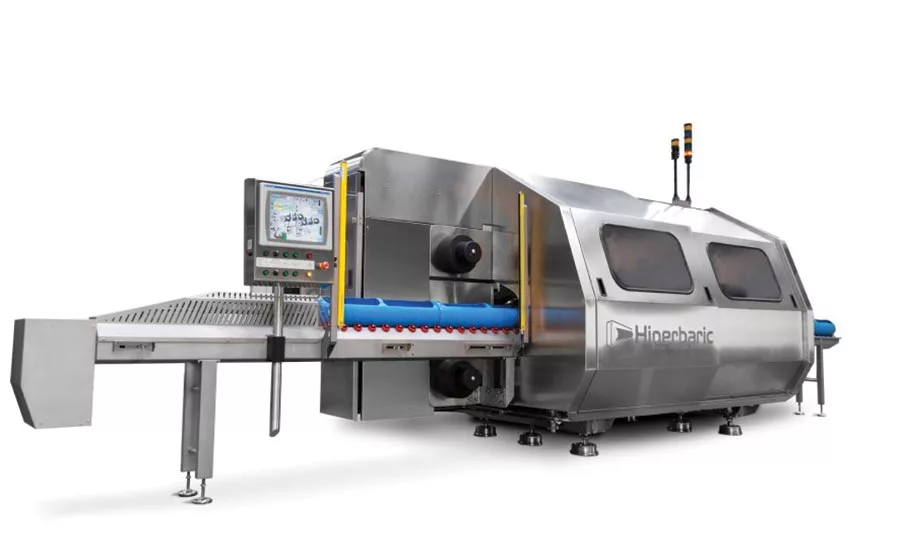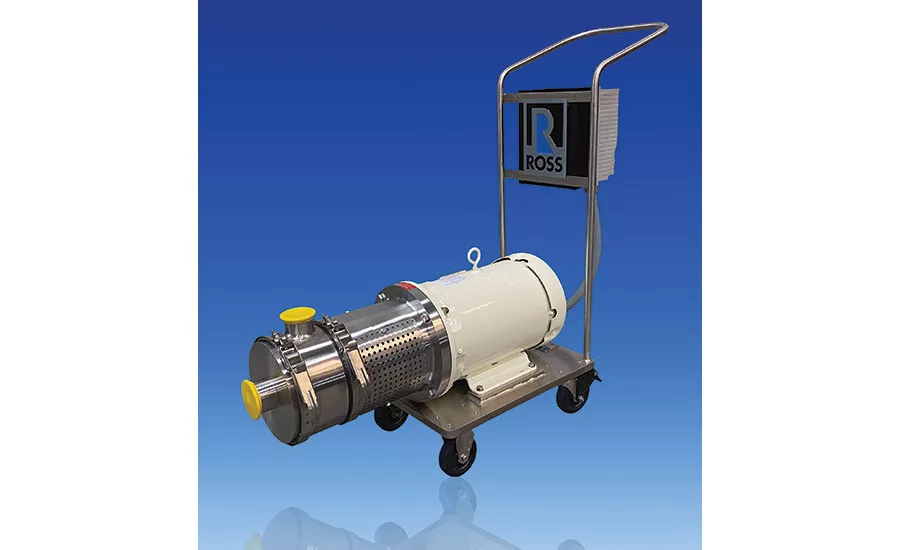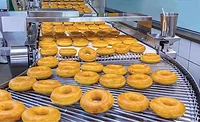Pet Food
Pet food: Safety and quality count
While pet food production continues to flourish during the pandemic, processors take quality and safety seriously

Blue Ridge Beef installed an AV-10 HPP food processing machine, like the one pictured here, from JBT/Avure. Suitable for small- and medium-size producers, the machine handles a high quantity of output and adds a minimal cost per pound to processing costs.
Photo courtesy JBT/Avure

Steve’s Real Food uses Raw Advantage Processing, an HPP toller that uses the Hiperbaric 55 machine to process its raw pet food.
Photo courtesy Hiperbaric

Selecting the right mixer to address the viscosity, density, phase changes, optimal shear, temperature and other processing requirements of a particular application is the first step to minimizing contamination and other safety risks.
Photo courtesy Charles Ross & Son Company

TOMRA Foods offer its optical sorting technologies to renderers that turn the byproducts from animal food production into pet food ingredients.
Photo courtesy TOMRA Foods

X-ray inspection systems, like the WIPOTEC SC X-ray scanner, can be used for pet food product inspection.
Photo courtesy WIPOTEC-OSC
While many industries have taken a hit during the COVID-19 pandemic, the pet product market seems to be doing well.
According to the American Pet Products Association, retail pet supply sales in the U.S are expected to reach $99 billion in 2020, up from $95.7 billion in 2019. Some might ascribe this to a surge in pet adoptions during the initial pandemic lockdown period. The American Society for the Prevention of Cruelty to Animals reported a 70% spike in pet adoptions in New York City and Los Angeles alone in spring 2020. The so-called Pet Effect—the positive effect that our dogs and cats have on our health—has never been as prevalent as it has in 2020, and humans respond in kind by feeding them quality food that has been made as safely as possible.
Elaine Vanier, technical manager of supply chain food safety audits at NSF International, says that prior to 2020, the pet food industry was already subject to high scrutiny, as many specifiers required third-party audits as part of their vendor approval process.

The COVID-19 pandemic forced pet food manufacturers to rely on new suppliers and ingredients, and made in-person audits difficult.
–Elaine Vanier,
technical manager of supply chain food safety audits at NSF International
“These audits evaluate the systems a facility has in place to ensure compliance and identify where critical processes are present,” she says. Typical hazards may include pathogens that can impact animals and humans; chemical and physical contaminants; products that require specialized storage requirements, e.g., refrigeration; and verification of ingredient suppliers in increasingly diverse and expanded (globally) supply chains with differing degrees of requirements and controls.
“The COVID-19 pandemic, however, created new challenges for pet food manufacturers as reduced availability of ingredients have forced many to rely on new suppliers and ingredients,” she says. “With travel restrictions and safety measures in place that limit face-to-face interactions, in-person facility audits have also become more difficult to arrange and present their own set of complications (connectivity, accessibility, security, etc.).”
So how can pet food manufacturers ensure that Fido’s food is high in quality and safe to consume? All pet food manufacturers must address the same basic principles of food safety as their human food counterparts.
“This is achieved by focusing on points of control,” says Vanier, “whether that may be before ingredients are received, during manufacture or packaging, or after shipment. Hazard analysis and critical controls are specific to the final product specifications, storage requirements and the end user.”
The right mixing equipment, for example, plays a major role in creating the product exactly to specifications, according to Christine Banaszek, sales manager at Charles Ross & Son Co. It carries out the desired homogenization, solubilization, emulsification, powder wet-out and deagglomeration. “Poor mixing will invariably manifest as inconsistencies in stability, texture, taste, color, potency and overall quality,” she says.

The right mixing equipment guards against inconsistencies in stability, texture, taste, color, potency and overall quality.
–Christine Banaszek,
sales manager at Charles Ross & Son Co.
Additionally, she says the phases of raw materials and the finished product are key considerations in mixer selection.
“Pet foods often require several mixing steps to produce the sauce, flavoring, coating, dry powder blends, dough and other intermediates. Once the appropriate mixer is identified for a specific part of the process, ideally through actual testing, pet food processors and equipment suppliers work together to identify the features that would best serve that particular mixing process.”
For example, she says these include premium stainless steel components to prevent corrosion; FDA-compliant elastomers; easy access to blades and agitators; proper welds and polish to promote easy cleaning and prevent potential contamination; vacuum design; jacketed mixing vessel; interchangeable vessels; and sanitary fittings.
“From our perspective as a mixing equipment supplier, proper mixer selection is the foundation to ensuring consistent quality and safety,” Banaszek says. “Selecting the right mixer to address the viscosity, density, phase changes, optimal shear, temperature and other processing requirements of a particular application is the first step to minimizing contamination and other safety risks.”
Sorting technology is another way to ensure the safety and quality in pet food. TOMRA Food has begun to offer its optical sorting technologies to renderers that turn the byproducts from animal food production into pet food ingredients. The company reports this new initiative is expected to be especially well-received now that the economic pressures of the COVID-19 pandemic are making it more important than ever for renderers to maximize efficiency and minimize waste.
Last year, TOMRA Food became the first to provide advanced sorting solutions for pet food producers. Because this was successful, the next step was to expand the company’s offering to pet food renderers.
Achieving higher commercial values requires higher standards, necessitating the detection and removal of the smallest fragments of foreign material from the product mix, the company reports.
Lars Povlsen, sales manager, pet food, TOMRA Food, says the company’s sorting technologies help ensure that pet food ingredients are safe and nutritious.

Achieving higher commercial values for pet food requires higher standards, necessitating the detection and removal of the smallest fragments of foreign material with optical sorters.
–Lars Povlsen,
sales manager, pet food, TOMRA Food
Jim Renehan, senior marketing manager for WIPOTEC-OCS, a manufacturer of in-motion weighing and X-ray scanning equipment, adds that pet food manufacturers use product inspection during the production and packaging processes that ensure that products have the correct fill weight and are free of foreign body contaminates.
“Like human food, the Federal Food, Drug and Cosmetic Act (FDA 21 CFR 113) requires that pet food be ‘safe to eat, produced under sanitary conditions, contain no harmful substances and be truthfully labeled,’” he says. “Effective, in-motion product inspection is a key factor in ensuring safety. A recent study of dog and cat owners found that over 70% of pet owners agree with the statement, ‘High-quality pet food is effective for preventive health care.’ Other studies indicate that pet owners are more interested in pet food products having clean labels,” he says.
Clean labels in this context mean that the pet food contained within the package is exactly what the label states, in terms of weight and product purity. Dynamic product inspection technologies are used by manufacturers to ensure the label matches the contents of the package.

Product inspection provides a clean label benefit of assuring consumers that pet food in the package is exactly what the label states, in terms of weight and product purity.
–Jim Renehan,
senior marketing manager for WIPOTEC-OCS
Renehan is not allowed to mention specific customer names, but he offers several examples of how WIPOTEC’s systems are used by pet food manufacturers. For instance, X-ray product inspection prevents pet food shipments containing foreign bodies from reaching the market.
“The type of X-ray scanner deployed depends on several application parameters, including where in the pet food manufacturing process the scanner is needed and the type of product inspection tasks the scanner needs to perform,” he says.
During prebagger/package filler, Renehan says that usually the SC-B X-ray scanner is used for X-ray foreign body inspection of the bulk pet food. During post-bagger/package filler, there are a number of options available, such as the SC-E and SC line of X-ray scanners. The correct choice is dictated by application parameters, such as package type, speed and product orientation, while packaging and manufacturing requirements affect checkweigher decision.
HPP and the raw pet food trend
One of the latest feeding trends is a raw pet food diet. According to “Guidance for the Raw Pet Food Industry,” by Hiperbaric, diets such as BARF (biologically appropriate raw food or bones and raw food) based in raw meat products present several benefits, such as improved nutrition, healthier/regular digestion, cleaner teeth, shinier coat and relief from food allergies/sensitivities.
However, raw pet food could pose a health risk for animals and humans since it can be contaminated with foodborne pathogens. The meat or muscle of a dead animal is sterile but susceptible to cross-contamination by E. coli, Salmonella, Listeria monocytogenes and other pathogens during slaughter and/or other operations (i.e., grinding) if it gets in touch with other organs or contacts with contaminated surfaces.
The CDC and FDA have multiple resources to communicate with consumers about the risk associated with unprocessed meat diets. Pet food processors also jeopardize pet and pet owner safety, along with brand trust and economic losses, if the potential presence of pathogens in pet food mandates a recall.
High pressure processing inactivates the main pathogens associated with raw pet food, according to Roberto Peregrina, chief scientific technologist, Hiperbaric. “HPP is becoming increasingly popular in pet food manufacturing to ensure the safety and quality of raw pet food.”

Manufacturers are increasingly turning to high pressure processing to inactivate the pathogens in raw pet foods.
–Roberto Peregrina,
chief scientific technologist, Hiperbaric
HPP inactivates E. coli, Salmonella and Listeria monocytogenes, making the food safe for pets and pet parents. “It also reduces spoilage microorganisms. HPP is a natural, nonthermal process that reduces the need for chemical additives and preservatives, enabling the nutritional, sensorial and textural characteristics of the unprocessed product,” Peregrina says.
Errol Raghubeer, senior vice president of R&D at JBT/Avure, points out that HPP is strongly recommended by the FDA as a food safety intervention step for raw pet foods.
“Pet food manufacturers are increasingly turning to HPP to ensure product safety and expand market opportunities. HPP is used extensively in the pet food industry to inactivate pathogens to keep both pets and humans safe from dangerous cross-contamination,” he says. “It extends refrigerated shelf life; preserves the flavor, texture and nutrients in raw food ingredients; and provides a safe alternative for immunocompromised dogs and cats who would otherwise not be able to eat a raw diet.”

The FDA strongly recommends high pressure processing as a food safety intervention step for raw pet foods, which are growing in popularity.
–Errol Raghubeer,
senior vice president of R&D at JBT/Avure
Take Blue Ridge Beef, for example, a company that began manufacturing raw meat products to supply the greyhound racing industry with a quality and nutritious food for the animal athletes.
“As we progressed in the pet food industry, we felt it was necessary to bring these same wholesome foods into households, so that companion animals can get the optimal nutrition that had been lacking in other commercial diets,” says Dustin Lea, quality assurance and food safety coordinator, Blue Ridge Beef. “We have always believed that our pets should be fed a diet closest to what they would have in the wild and have worked diligently to deliver that to our customers.”
The company began utilizing HPP in late 2018 “as a more trustworthy method to eliminate harmful pathogens in our products while leaving the nutritional benefits unchanged,” says Lea. The company used a Universal Pure tolling facility for a short period while making plans to bring a machine into its facility. The pet food maker ultimately installed a JBT Avure AV-10 HPP machine, with an annual capacity of 10 million pounds.
“We wanted complete oversight of the quality of our products from beginning to end,” says Lea. “We chose high pressure processing as a pathogen control for its effectiveness on harmful bacteria as across the board. We see at least a seven-log reduction in the bacteria that are present in our products with this process. This immensely increases the safety of our products with small effects on overall quality.”
Steve’s Real Food of Cottonwood, Utah, is another raw pet food manufacturer that uses HPP to preserve and package its product. Prior to HPP, the company experimented with many kill steps to eliminate foodborne pathogens.
“We tested acid sprays, biophages, test and hold, probiotic sprays, and environmental controls,” says owner Nicole Lindsley. “These were effective methods, but none of them could produce a 5-log reduction, which is what our goal was. After working with Hiperbaric, we were able to fine-tune our HPP process to achieve the 5-log reduction, complete a validation study and ensure the food was not nutritionally compromised.”
All five of Steve’s Real Food raw meat diets use grass-fed meats and antibiotic-free poultry. The company sources its produce locally to ensure quality and reduce its carbon footprint. Its target market is pet lovers who are not only nutritionally motivated but environmentally conscious.
Steve’s Real Food started exploring HPP with Hiperbaric a couple years ago when it became necessary to have validated kill steps to adhere to the FDA’s zero-tolerance policy for foodborne bacteria in raw pet food. The company conducted extensive research and tested the nutritional makeup of pre- and post-HPP food. After the tests determined there was not a significant degradation to the food, the business began using HPP on its poultry products to test the market’s response to the change.
“After another year of research, we discovered that not only would HPP allow us to mitigate the harmful microbial environment, but it would also allow us to preserve the food without chemicals and with extended shelf life,” Lindsley says. “This is why we decided to use HPP.”
Steve’s Real Food uses Raw Advantage Processing, an HPP toller that uses the Hiperbaric 55 machine to process its raw pet food. Today, Lindsley is an HPP advocate, conducting consumer awareness efforts to educate pet owners about the method’s benefits.
Raw Advantage President Ryan Minch says, “We started using the Hiperbaric equipment in 2017. I was familiar with the HPP process and had used other equipment for several years before at a different company.” The company chose Hiperbaric because it had a machine that was the right size for its plans for testing and R&D before scaling up.
Lindsley says that HPP will ensure the growth of the raw pet food sector, as more consumers and retailers are educated about it. “As they become more knowledgeable, more pet owners will try raw pet food knowing that with HPP it is safe, nutritional and free of pathogens.”
For more information:
American Pet Products Association, www.americanpetproducts.org
NSF International, www.nsf.org
Charles Ross & Son Co., www.mixers.com
TOMRA Foods, www.tomra.com
WIPOTEC-OCS, www.wipotec-ocs.com/us
Blue Ridge Beef, www.blueridgebeef.com
Steve’s Real Food, www.stevesrealfood.com
Hiperbaric, www.hiperbaric.com
JBT/Avure, www.jbtc.com
Looking for a reprint of this article?
From high-res PDFs to custom plaques, order your copy today!








